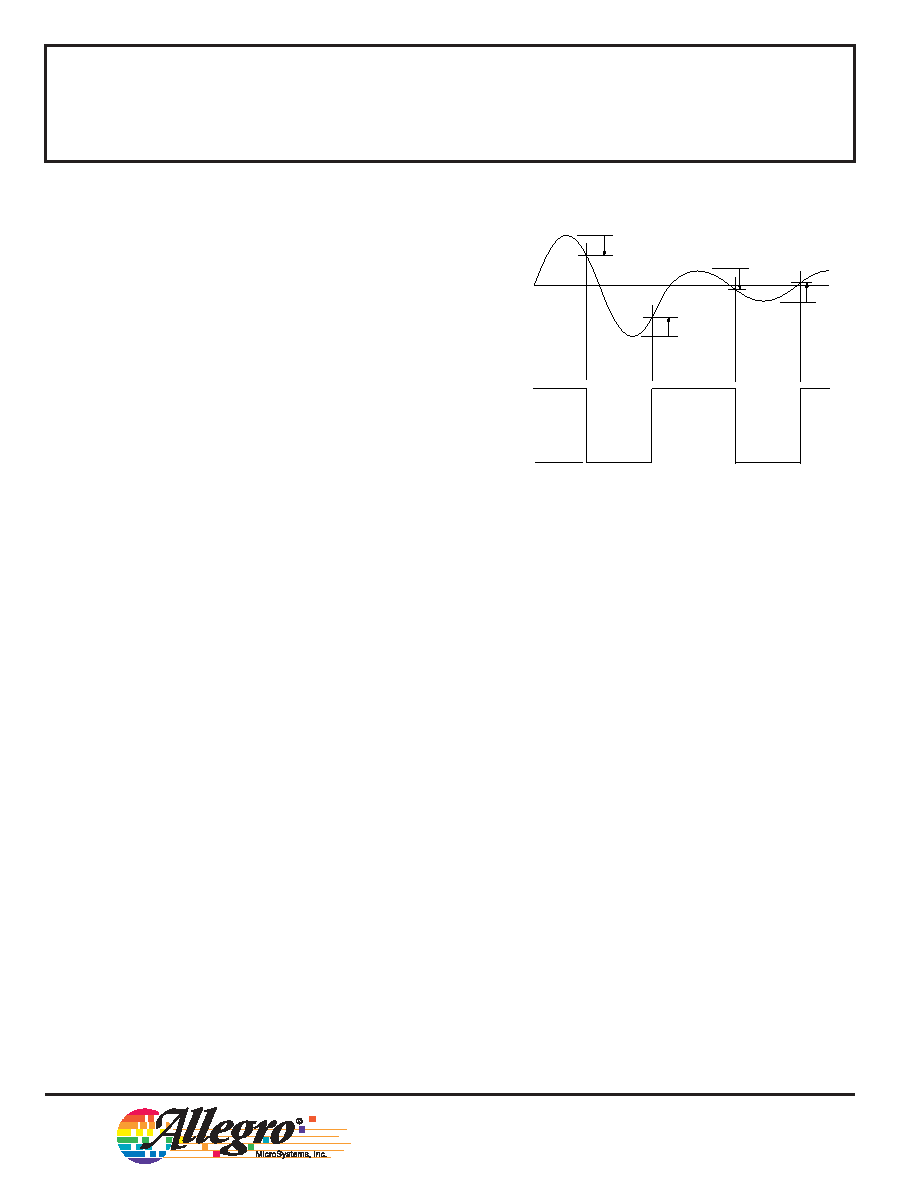- 您現(xiàn)在的位置:買賣IC網(wǎng) > PDF目錄67389 > ATS612LSB PROXIMITY SENSOR-HALL EFFECT, 0.4-2.5mm, 0.40V, ROUND, THROUGH HOLE MOUNT PDF資料下載
參數(shù)資料
| 型號: | ATS612LSB |
| 元件分類: | 速度傳感器和接近開關(guān) |
| 英文描述: | PROXIMITY SENSOR-HALL EFFECT, 0.4-2.5mm, 0.40V, ROUND, THROUGH HOLE MOUNT |
| 封裝: | PLASTIC PACKAGE-4 |
| 文件頁數(shù): | 17/17頁 |
| 文件大小: | 386K |
| 代理商: | ATS612LSB |

115 Northeast Cutoff, Box 15036
Worcester, Massachusetts 01615-0036 (508) 853-5000
ATS612LSB
DYNAMIC, SELF-CALIBRATING, PEAK-DETECTING,
DIFFERENTIAL HALL-EFFECT GEAR-TOOTH SENSOR
8
Dwg. WH-011
V
OUT(SAT)
V
BB
OUTPUT
DIFFERENTIAL
MAGNETIC
FLUX
OPERATE
RELEASE
OPERATE
RELEASE
0
The ATS612LSB gear-tooth sensor system is a Hall
IC/magnet configuration that is fully optimized to provide
digital detection of gear-tooth edges in a small package
size. This device contains self-calibrating circuitry that
nulls out the effect of air gap variations on the switching
accuracy of the device. A high startup hysteresis mini-
mizes false switching caused by magnetic overshoot. The
sensor is packaged in a miniature plastic housing that has
been optimized for size, ease of assembly, and
manufacturability. High operating temperature materials
are used in all aspects of construction.
The use of this sensor is simple; after correct power
is applied to the component, it is capable of instantly
providing digital information that is representative of the
profile of a rotating gear. No additional optimization or
processing circuitry is required. This ease of use should
reduce design time and incremental assembly costs for
most applications.
Sensing Technology. This gear-tooth sensor module
contains a single-chip differential Hall-effect sensor IC, a
samarium-cobalt magnet, and a flat ferrous pole piece.
The Hall IC consists of two Hall elements located so as to
measure the magnetic gradient created by the passing of a
ferrous object (a gear). The two elements measure the
field gradient and convert it to voltage which is then
subtracted and processed in order to provide a digital
output signal.
The processing circuit uses a patented peak detec-
tion scheme to eliminate magnet and system offsets. This
technique allows dynamic coupling and filtering of offsets
without the power-up and settling time disadvantages of
classical high-pass filtering schemes. The peak signal of
every tooth and valley is detected by the filter and is used
to provide an instant reference for the operate and release
point comparator. In this manner, the thresholds are
adapted and referenced to individual signal peaks and
valleys, hence providing immunity to zero line variation
due to installation inaccuracies (tilt, rotation, and off center
placement), as well as for variations caused by target and
shaft eccentricities. The peak detection concept also
allows extremely low speed operation for small value filter
capacitors.
DEVICE DESCRIPTION
The ATS612LSB also includes self-calibration
circuitry that is engaged at power on. The signal ampli-
tude is measured and the device gain is normalized. In
this manner, switch-point drift versus air gap is minimized
and excellent timing accuracy can be achieved. The AGC
circuitry, in conjunction with a unique hysteresis circuit,
also eliminates the effect of gear edge overshoot as well
as increases the immunity to false switching caused by
gear tooth anomalies at close air gap. The AGC circuit
sets the gain of the device after power on. Up to 0.25 mm
air gap change can occur after calibration is complete
without significant performance impact.
Superior Performance. The ATS612LSB peak-detecting
differential gear-tooth sensor module has several advan-
tages over conventional Hall-effect gear-tooth sensors.
The signal-processing techniques used in the ATS612LSB
peak-detecting differential gear-tooth sensor solve the
catastrophic issues that affect the functionality of conven-
tional digital gear-tooth sensors.
Temperature drift. Changes in temperature do not
greatly affect this device due to the stable amplifier
design and the offset rejection circuitry.
Timing accuracy variation due to air gap. The
accuracy variation caused by air gap changes is
minimized by the self calibration circuitry. A 2x-to-3x
improvement can be seen.
Dual edge detection. Because this device switches
from the positive and negative peaks of the signal, dual
edge detection is guaranteed.
相關(guān)PDF資料 |
PDF描述 |
|---|---|
| ATS612LSG | PROXIMITY SENSOR-HALL EFFECT, 0.4-2.25mm, 0.90%, 0.18-0.40V, THROUGH HOLE MOUNT |
| ATS616LSGTN-T | PROXIMITY SENSOR-HALL EFFECT, 0.4-2.5mm, 200-400mV, RECTANGULAR, THROUGH HOLE MOUNT |
| ATS625LSGTN-T | PROXIMITY SENSOR-HALL EFFECT, 0.5-2.5mm, 200-450mV, RECTANGULAR, THROUGH HOLE MOUNT |
| ATS630LSA | PROXIMITY SENSOR-HALL EFFECT, 0.3-2.5mm, 0.20-0.40V, ROUND, THROUGH HOLE MOUNT |
| ATS631LSA | PROXIMITY SENSOR-HALL EFFECT, 0.3-2.5mm, 0.20-0.40V, ROUND, THROUGH HOLE MOUNT |
相關(guān)代理商/技術(shù)參數(shù) |
參數(shù)描述 |
|---|---|
| ATS612LSB_1 | 制造商:ALLEGRO 制造商全稱:Allegro MicroSystems 功能描述:Dynamic, Self-Calibrating, Peak-Detecting, Differential Hall Effect Gear Tooth Sensor |
| ATS612LSG | 制造商:ALLEGRO 制造商全稱:Allegro MicroSystems 功能描述:DYNAMIC, SELF-CALIBRATING, PEAK-DETECTING, DIFFERENTIAL HALL-EFFECT GEAR-TOOTH SENSOR |
| ATS-61300D-C1-R0 | 功能描述:散熱片 FANSINK ASSY 29.25X29.25X9.5 (MM) RoHS:否 制造商:Ampro By ADLINK 產(chǎn)品:Heat Sink Accessories 安裝風(fēng)格:Through Hole 散熱片材料: 散熱片樣式: 熱阻: 長度: 寬度: 高度: 設(shè)計目的:Express-HRR |
| ATS-61300K-C1-R0 | 功能描述:散熱片 FANSINK ASSY 29.25 X 29.25 X 14.5 (MM) RoHS:否 制造商:Ampro By ADLINK 產(chǎn)品:Heat Sink Accessories 安裝風(fēng)格:Through Hole 散熱片材料: 散熱片樣式: 熱阻: 長度: 寬度: 高度: 設(shè)計目的:Express-HRR |
| ATS-61300R-C1-R0 | 功能描述:散熱片 FANSINK ASSY 29.25 X 29.25 X 19.5 (MM) RoHS:否 制造商:Ampro By ADLINK 產(chǎn)品:Heat Sink Accessories 安裝風(fēng)格:Through Hole 散熱片材料: 散熱片樣式: 熱阻: 長度: 寬度: 高度: 設(shè)計目的:Express-HRR |
發(fā)布緊急采購,3分鐘左右您將得到回復(fù)。